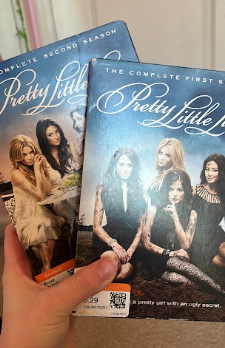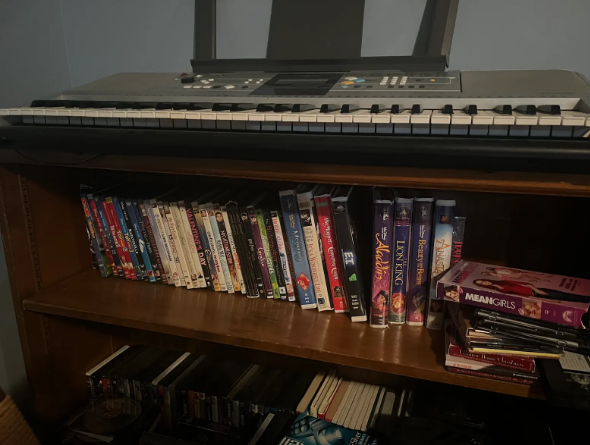I remember in my early childhood when my parents would rent movies from Netflix. My brother and I would run to the mailbox and rip open the thick red envelope, excited to see what we were going to watch over the weekend. This was when Netflix offered a DVD-rental service, a facet of television that has since been left in the dust.
DVDs, like the ones Netflix used to rent out, can be described as a form of physical media. Physical media is a category used to describe tangible mediums used to store or transmit information. Common forms of physical media, such as CDs, DvDs, VHS tapes and vinyl, are quickly becoming obsolete.
But should we be so quick to let go of this form of content?
Physical media once dominated the music and entertainment industry. According to an article in Beat Release detailing the history of physical media, the first form of physical media, the phonograph, was introduced in 1877. The phonograph is a device that produces music using a rotating record table. The sound of the grooves against the stylus produce the specific sound of each song and is amplified by an acoustic horn located on the top.
The phonograph paved the way for a slew of inventions throughout the next century. From record players to CDs and cassette tapes, physical media sales were booming.
After television gained popularity in the 1950s, it was only a matter of time before shows that could once only be seen on broadcast were developed into forms of physical media. The first VHS system was invented in 1971 and continued to gain popularity over the 1980s and 1990s. A movie in the form of a VHS tape could be purchased at a video rental store or large retail stores such as Blockbuster or Walmart. Once purchased, all you had to do was insert the tape into your home VCR player and the movie would begin.
DVDs came out in 1995 and gained popularity over the next decade. DVDs were seen as superior to VHS due to being smaller, more portable and having increased audio and visual quality. Additionally, while VHS tapes had to be “rewinded”, which could easily take several minutes, DVDs offered the option for immediate scene selection.

And in 2006, an ever higher quality form of media was introduced: Blu-Rays. Blu-Rays were very similar to DVDs, however, had even higher resolution, producing sharper, clearer images, and had an immersive sound quality.
However, in the 2000s, a new trend emerged alongside DVDs and Blu-Ray: streaming content. Streaming is a way of transmitting content using the internet. Streaming sites such as Netflix contain an extensive library of movies and television shows which can be watched at any time without ever making a physical purchase. All of this can be done from the comfort of one’s own home. The only requirement is that one must pay a subscription fee to the service.
Netflix is the most popular and prominent streaming service to this day. Netflix’s streaming service, entitled “Watch Now”, began in 2007, and was available alongside their DVD-by-Mail Service, which began in 1997. In 2010, Netflix released their first streaming-only plan, and it took off. According to Business of Apps, Netflix’s streaming site has over 300 million subscribers in 2025. The DVD service was finally shut down in 2023.
Netflix’s popularity inspired many other streaming sites which have become prominent names in the industry such as Max, Peacock and Disney+. More of these sites are being released each year.
Streaming also overtook the music industry with the first ever dip in record sales occurring in 2000 after digital audio file distribution site Napster became popularized. Despite Napster being shut down due to concerns of copyright and infringement in 2001, according to Britannica, the idea of streaming music online had already been planted. Sites such as Spotify and Pandora were released in the next few years and had surpassed CD sales by 2014, according to LAist.
And it’s not surprising streaming has many advantages. New music and shows have never been so easily accessible.
There is one word that can sum up the main advantage of streaming: convenience. On music streaming sites like Spotify, one can select individual songs to purchase, rather than buying the whole album. Additionally, when someone pays for a subscription to a streaming site like Netflix, thousands of TV shows and movies are at their fingertips. This content spans decades, from “The Brady Bunch” (1969) to “Friends” (1994) and even the show “Outer Banks” (2020). And streaming content is not limited to just a television, anyone can watch on a phone, tablet or a computer. To summarize, consumers now have the ability to pick what, when and where to watch without ever leaving their homes.
However, streaming is not without its faults.
Music streaming sites have been criticized from the start with “Napster” rapidly being shut down due to copyright concerns. Streaming sites often do not properly credit artists, and the royalties made are much lower. This is especially difficult for independent artists.
Streaming sites are also rapidly becoming more expensive. Initially, streaming services were less expensive than buying physical media, and served as a much needed alternative to the increasing cost of cable networks. When Netflix first began streaming online in 2007, a subscription only cost $7.99 per month, according to Looper.
At the time, streaming was much more cost-effective. Instead of paying $7.99 for one DVD, you could purchase a Netflix subscription and get hundreds of movies for the same cost.
But, over time, streaming sites are becoming less and less affordable. In 2025, a “standard” Netflix subscription costs $17.99. Additionally, rising subscription costs are not the only thing contributing to the expense of physical media.
Every year, more streaming services launch, and the content gets divided between these streaming services. Apple TV+, Prime Video and Hulu are only a few examples of the wide selection of popular streaming services. This means a consumer must now pay for more services to get the same range of TV and movie options they previously had access to. People end up signing up for endless numbers of streaming services, and the cost of these subscriptions add up.
A survey from Finance Buzz found that 1 in 4 Americans spent more than $75 a month or more on streaming services. Additionally, 1 in 10 were not even sure how much they spent each month.
So, what is the solution here?
We have come full circle in terms of pricing. With the rising cost of streaming and low demand for physical media, physical media is becoming the more affordable option. Walmart has bins of DVDs available for only $5, and it is possible to find them for $1.99 at Goodwill. Many libraries also have DVD sections, which you can rent for free. This offers a cost-effective alternative to streaming.
Furthermore, physical media also possesses a quality streaming services do not: a sense of permanence. If people physically buy their favorite album or TV show, it will belong to them forever. There is something comforting about holding your favorite movie in your hands, knowing you can watch it at any time. But with streaming services, there is no sense of permanence or specific attachment to any singular content.
It is the sites that choose what content they display at what time, and this content gets cycled through every month. Once the licensing agreement ends, there is no guarantee a viewer will have access to ever see the show again. Someone’s favorite movie could be available one day and gone the next.
It is for these reasons I believe we should keep physical media in circulation. While I do not think we should get rid of streaming services entirely, I do believe owning a portion of physical media would be beneficial to our society in terms of cost and permanence.
Some may argue that streaming is better than purchasing physical media because streaming in general offers better quality than physical media. Content types such as VHS types are considered to be low-quality due to the low resolution rate. It is easy to put all physical media into a box with older forms of content such VHS tapes. However, this is too broad of a view, considering each type of physical media is different.
In contrast to VHS, Blu-Ray is held in higher regard than streaming, despite its lack of popularity. Blu-Ray has a higher bitrate, according to The Verge which means they have higher quality sound and video than streaming. Although much attention has been paid to streaming TV and film, music is much the same. Vinyl has long been regarded as the “purest” form of music production, with what many describe as a “warmer” sound and fuller dynamic range (AV Blog).

In turn, it is clear that the “quality” argument here does not work to undermine the benefits of physical media.
In conclusion, whereas streaming can be convenient and useful in everyday life, keeping physical media in circulation is important for many reasons, whether it be cost, permanence or quality. Your favorite movie with the same familiar intro is still sitting on your bookshelf, ready to be watched on a rainy day.








